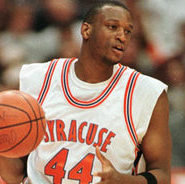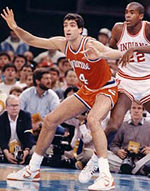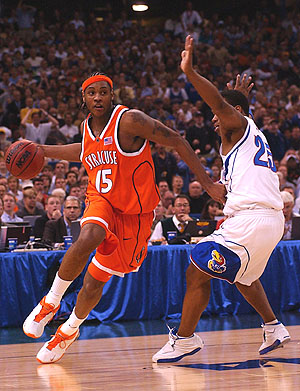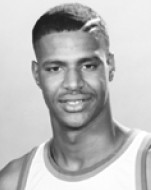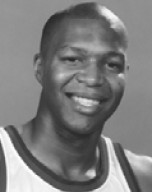It is difficult to compare teams from different eras, as the
game of basketball changes in terms of style, rules and size of the players.
And yet, it can be an interesting exercise to go through.
The 1986-1987 Orangemen and the 2002-2003 Orangemen both
played their National Championship games in New Orleans, with the final results
differing. As Syracuse fans vividly know, 2003 was the lone NCAA National
Championship, while 1987 was a heart breaking loss on a Keith Smart shot.
The two teams had a lot of similarities. Both teams improved as the season went along,
and were playing their best basketball during the NCAA tournament. Both teams were of course coached by Jim
Boeheim. Both teams had leads in the
NCAA Championship game, and struggled to make their free throws during the last
minute. In both cases the star freshman forward (Derrick Coleman and Carmelo
Anthony) missed the front end of a one-and-one that could have sealed the
win. In both cases a senior forward
(Howard Triche and Kueth Duany) missed the front end of a one-and-one that
could have also sealed the win. The most
clear difference in the championship game is that in 2003 Hakim Warrick blocked
Michael Lee’s 3 point shot attempt, whereas Howard Triche could not cover Keith
Smart’s 2 point shot.
The two teams, however, were different in many ways. The
1987 team started the season ranked #15 in the country, and would rise to #5.
They were 5-6 versus AP Top 20 teams, including three losses to Georgetown
(including two classics). They won the
Big East Regular Season title, and lost in the BET Championship to the Hoyas.
The 2003 team started the year unranked and did not crack
the top 25 until January 19th; they would actually drop out of the top
25 again, and then return for the rest of the season on January 26th. The team was 7-2 versus AP Top 25 teams, and
beat Georgetown three times. They would not win the Big East regular season
title nor make it to the BET Championship game.
The 1987 team had balanced scoring with five different players
averaging 10+ points a game. Those five players also all scored 20 or more
points in at least one game, and three of them (Triche, Sherman Douglas and
Rony Seikaly) scored 30+ points in a game.
There were a lot of options for who would lead the team in scoring on a
given night.
The 2003 team had four players scoring 10+ points a
game. Five different players did score
20 or more points in a game, but make no mistake about it, that Anthony was the
alpha dog on scoring, and led the team in scoring most nights.
The 1987 team had more collegiate experience. The starting five consisted of two seniors, a
junior, a sophomore and a freshman. 2003
had one senior, two sophomores and two freshmen.
The 1987 Orangemen played both zone and man-to-man, along
with a mix of full court press. Zone
defense was typically used in inbound situations in the half court, whereas
man-to-man was used in normal routines.
Syracuse was comfortable pressing a lot utilizing Seikaly as the last
line of defense if the press was broken.
The three point shot had just been introduced in 1987, and college teams
in general were not geared towards preventing it. Syracuse did play Providence, a Rick Pitino
team that lived-and-died by the three point shot, and the Orangemen did beat
them three times. They did have problems
with Steve Alford in the NCAA Championship with Alford hitting 7 of 10
attempts, though a few of those were on fast breaks where he pulled up and took
the shot from the arc as the defender back pedaled.
In 2003 Syracuse was playing its vaunted zone defense almost
exclusively, and the team played it very well by the season’s end. Gerry McNamara was very good at picking off
passes in the lane, and Duany made an intimidating guard at 6’5” at the
top. The back of the Syracuse zone was
tall and long limbed with 6’8” Anthony, 6’8” Warrick and 7’0” Craig Forth. Jeremy McNeil would offer a change of pace on
defense, and was the shot blocking expert in the back line. The three point shot had been well
established by 2003, and the Orangemen were very good at closing out on
perimeter shooters.
Offensively the 1987 Orangemen played an up tempo game, and
loved to push the pace of the game.
Despite being up tempo, they did a decent job of not being too careless
with the ball. Sherman Douglas had a 2.4
assist to turnover ratio, and his backcourt mate Greg Monroe was even better at
2.9.
The Orangemen loved to score from the inside, relying on
Seikaly and Coleman to pound the ball home.
Douglas was the master of the alley oop pass and he would lob the ball
over defenses allowing the very athletic Seikaly, Coleman and Stephen Thompson
to dunk the ball home. Monroe was the
only real three point threat, and he became very adept at it hitting 44% of his
attempts. Monroe basically camped out on
the three point arc, and Douglas would drive and kick the ball back out to
him. Douglas was extremely good at driving
the lane and putting up the soft floater, or dish off to the big mean down low. The team was fortunate to have two pure point
guards in Douglas and Monroe.
The 2003 Orangemen ran all of their offense through Carmelo
Anthony. Melo was the most gifted
offensive freshman that Syracuse has ever had.
He had good ball handling skills, excellent moves to the hoop with a
short jumper and a decent three point shot.
Billy Edelin became more integral into the team as the post season
progressed, but the offense was run by Gerry McNamara. GMac was not a true point guard, but he ran
the offense well. He was a sniper with a reputation for making the clutch
shots. Warrick wasn’t a main threat on
offense, but he got enough touches to become effective as the third
option. Duany was decent all around, and
offered a very good third three point shooting options, behind GMac and
Melo. The team had a decent perimeter
attack, and an alpha dog to run the offense through.
Both teams had an Achilles heal with their free throw
shooting. The best free throw shooter on
each team was the point guard, which helped in close games. Douglas hit 74% of his shots, while McNamara
hit a blistering 91%. For 1987, Monroe
and Triche were okay, Coleman and Seikaly were marginal, and Thompson and Derek
Brower, both from the bench were awful.
For 2003, Anthony was okay from the free throw, while Duany,
Warrick and Edelin were marginal. Forth,
Josh Pace and Jeremy McNeil were terrible.
How would the two teams match up?
Point Guard: 6’
Sherman Douglas versus 6’2” Gerry McNamara. Douglas is definitely the better point
guard; we are talking about perhaps the best point guard in Syracuse history,
and that’s no disrespect to McNamara.
Douglas was quicker, and would likely be able to drive past GMac. GMac is clearly the better shooter, and the
height advantage over Douglas would help him. The 1987 team, because they
played a lot of man defense, may have put Monroe on McNamara. That could backfire, however, because that
meant that 6’ Douglas had to guard 6’5” Duany who was adept at hitting the
three. Stephen Thompson could come off
the bench and help shutdown McNamara or Duany, but Thompson wasn’t an integral
part of the offense in 1987. Overall,
edge to 1987.
Shooting Guard: 6’3” Greg Monroe versus 6’5” Kueth
Duany. Both were seniors. Monroe was by far the better shooter and the
better ball handler. He was very comfortable at running the offense when
needed. Duany would be the better
defender and rebounder, and while Monroe was the better shooter, Duany was not
a slouch. If Billy Edelin came into the
game and moved to the point, then Douglas would have had to guard him, and
Edelin at 6’4”, who specialized in backing defenders into the paint, may have
had a good time against Douglas. In that
scenario, Monroe would have been guarding McNamara. Tough to call. I would call it Even.
Small Forward: 6’5”
Howard Triche versus 6’8” Carmelo Anthony.
Triche was a senior and a solid all around player, but there is no
comparison here. Anthony, one of the greatest freshman players of all time, is
significantly better than Triche.
Syracuse would likely have had Derrick Coleman guard Anthony in man
defense, and that would have been very interesting. Coleman was a decent shot blocker and at 6’11”,
with a very long reach, Coleman would’ve been a tough matchup for Anthony. I do think the offensive expertise of Anthony
would have won out, but Coleman would have made him work for it. The 1987 team likely would have had Triche
attack the side of the zone that Anthony was on, and that would have pulled
Anthony a little further out from the hoop, but not much. Overall edge, 2003 by a lot.
Power Forward: 6’11” Derrick Coleman versus 6’8” Hakim
Warrick. Coleman was a raw offensive
player in 1987, with very good hands and the ability to make the short
jumper. His greatest ability was to
crash the boards for rebounds, and run the court. Warrick was coming into his own by the end of
the 2003 season, and had that explosive first step to the hoop. Warrick would have had a tough time matching
Coleman on defense, as Coleman’s height and reach would give him an
advantage. Warrick would have had Triche
to beat defensively, and Warrick’s speed and size would have helped him a lot
there, especially since Warrick played above the rim. Overall edge, 1987.
Center: 6’10” Rony Seikaly versus 7’0” Craig Forth and 6’8”
Jeremy McNeil. Forth and McNeil split
time at center, so that would give the 2003 Orangemen 10 fouls to use, and two
big bodies to keep fresh against Seikaly.
Seikaly was definitely better than either Forth or McNeil. He was much
more athletic, could run the court very well, and by the end of 1987 had developed
a short jumper and some nice post moves.
Forth likely would have been the tougher assignment for Seikaly as he
took up more space, and would make it tough for Seikaly to get to the hoop,
whereas McNeil could be pulled out of position on the block attempts. Seikaly handled centers much better than
Forth/McNeil in the 1987 NCAA season run.
Forth and McNeil would offer very little offensive against Seikaly. They both were limited offensively to begin
with, and Seikaly was a premier shot blocker in his era. The offensive liability of 2003 centers would
allow Seikaly to cheat and defend against other 2003 players going to the hoop.
Overall edge, 1987 by a lot.
Bench: The 1987 team
really went two players deep. Stephen Thompson was the backup shooting guard
and small forwards, and specialized in defense and running out for passes on
the fast break, as well as putting back loose balls for easy dunks and
layups. Derek Brower was the reserve big
man, and he was a load in the middle. Not much of an offensive threat, but
solid defensively. The 2003 team had
Josh Pace, the aforementioned Edelin, and McNeil. Pace would offer a good
change of pace for the 2003 team, something that the 1987 team really did not
have. At 6’5” he would have a
disadvantage against the tall 1987 front line, and Triche may have been able to
take him on. Overall edge goes to 2003.
Coaching: The 2003 Jim Boeheim was likely a better coach
than the 1987 Boeheim. Boeheim had 10
years of experience in 1987, whereas he had 26 in 2003. Overall edge goes to 2003.
The big questions would be the following:
·
Could the 1987 team run the ball as much as they
would want, or would the 2003 team be able to prevent it? If the 1987 team were
able to run the ball, could the 2003 team keep up with them?
·
Could the 1987 team slow down Melo? If they couldn’t, would they be able to
contain the rest of the team enough so that Melo didn’t matter?
·
Could the 2003 team slow down Seikaly?
·
Could the 1987 team guard the three point
shooting of the 2003 team?
·
Could the 2003 team handle the full court
pressure of the 1987 team?
In the end, I think the 2003 team would win the game. I think the 2003 team could handle the full
court pressure. Melo would be able to help bring the ball up court, and with him
and Duany helping in that area, they would be able to move the ball over the
press defense.
The 1987 team would have a tough time covering Duany or
Edelin, whomever was playing the other guard position to McNamara. I don’t think the 1987 team is going to stop
Melo; they may slow him down but not enough.
The question would be how much could Seikaly help Coleman on
defense. If he could rotate over, he
could have been very effective at stopping Melo.
Seikaly would probably have a big day offensively and defensively, but
he would get quite a workout against Forth/McNeil, and lest we forget, Warrick
and Anthony could collapse on defense and help double team.
Douglas would be very tough to stop on the penetration, and
he would get his points and his assists.
Douglas was able to master the alley oop in the NBA, so he would get the
pass off against anyone.
f the game was close, I would not want to be either squad
trying to protect the lead. I am not one of those fans who believe that Syracuse won the 2003 title only because of Melo. It was a complete team effort throughout the playoffs. But in this hypothetical matchup of 1987 versus 2003, I think he does bring matchup problems, especially with Warrick at the other forward position. And in the end
I think 2002-2003 beats 1986-1987.



